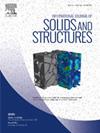Surface curvature regulation of 3D kirigami soft gripper
IF 3.8
3区 工程技术
Q1 MECHANICS
International Journal of Solids and Structures
Pub Date : 2025-04-25
DOI:10.1016/j.ijsolstr.2025.113410
引用次数: 0
Abstract
Kirigami principles have been integrated into flexible grippers, exploiting the shape transforming advantages to improve the grippers’ performance and broaden the varieties upon which can be operated. However, few studies have adopted the 3D polygonal auxetic kirigami as the main structure of the gripper, due to its complex spatial design process, narrowed means of fabrication and multi-freedom actuation. Herein, gripper deformation based on auxetic kirigami under a simple actuation of 1-DoF is studied via an energy minimization framework. Firstly, a spring potential energy minimization problem of the 3D kirigami with geometric constraints is solved to obtain its deployment path and energy landscape. Then the deformed surface is analyzed using discrete Gauss-Bonnet theorem, proposing a method to regulate the shape morphing into the targets. Finite element analysis is used to verify the kirigami design framework and shape prediction. Finally, different types of kirigami grippers are fabricated and tested, achieving effective conformation and grasping of typically shaped objects, while exhibiting universal, easily actuated characteristics. These findings contribute to advancing the field of robotic handling and manipulation, particularly in applications requiring gentle and compliant interactions with diverse and specifically delicate objects.
三维kirigami软夹持器的表面曲率调节
将基里伽米原理融入到柔性夹持器中,利用其形状变换的优势,提高夹持器的性能,拓宽夹持器的操作品种。然而,由于其空间设计过程复杂、制造手段狭窄、多自由度驱动等特点,采用三维多边形异形基立ami作为夹持器主体结构的研究较少。在此基础上,通过能量最小化框架,研究了在简单的1自由度驱动下,基于惯性基利格米的夹持器变形。首先,求解几何约束下三维基里伽米弹簧势能最小化问题,得到其展开路径和能量格局;然后利用离散高斯-博内定理对变形曲面进行分析,提出了一种调节曲面形状向目标变形的方法。采用有限元分析对基里伽米设计框架和形状预测进行了验证。最后,制作和测试了不同类型的基里伽米夹持器,实现了典型形状物体的有效构象和抓取,同时展示了通用的,易于驱动的特性。这些发现有助于推进机器人处理和操纵领域,特别是在需要与各种特别微妙的物体进行温和和顺从交互的应用中。
本文章由计算机程序翻译,如有差异,请以英文原文为准。
求助全文
约1分钟内获得全文
求助全文
来源期刊
CiteScore
6.70
自引率
8.30%
发文量
405
审稿时长
70 days
期刊介绍:
The International Journal of Solids and Structures has as its objective the publication and dissemination of original research in Mechanics of Solids and Structures as a field of Applied Science and Engineering. It fosters thus the exchange of ideas among workers in different parts of the world and also among workers who emphasize different aspects of the foundations and applications of the field.
Standing as it does at the cross-roads of Materials Science, Life Sciences, Mathematics, Physics and Engineering Design, the Mechanics of Solids and Structures is experiencing considerable growth as a result of recent technological advances. The Journal, by providing an international medium of communication, is encouraging this growth and is encompassing all aspects of the field from the more classical problems of structural analysis to mechanics of solids continually interacting with other media and including fracture, flow, wave propagation, heat transfer, thermal effects in solids, optimum design methods, model analysis, structural topology and numerical techniques. Interest extends to both inorganic and organic solids and structures.

 求助内容:
求助内容: 应助结果提醒方式:
应助结果提醒方式:


